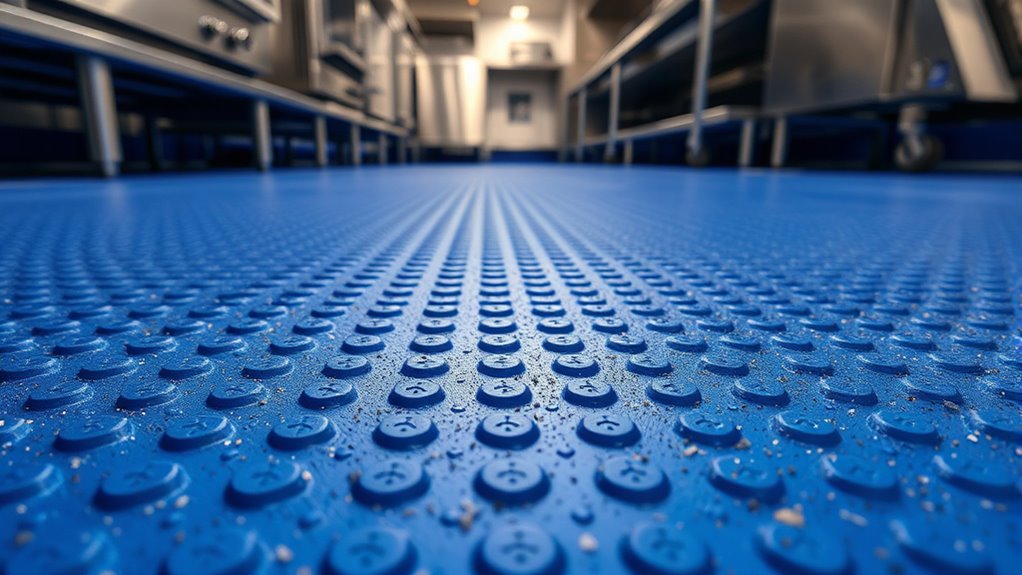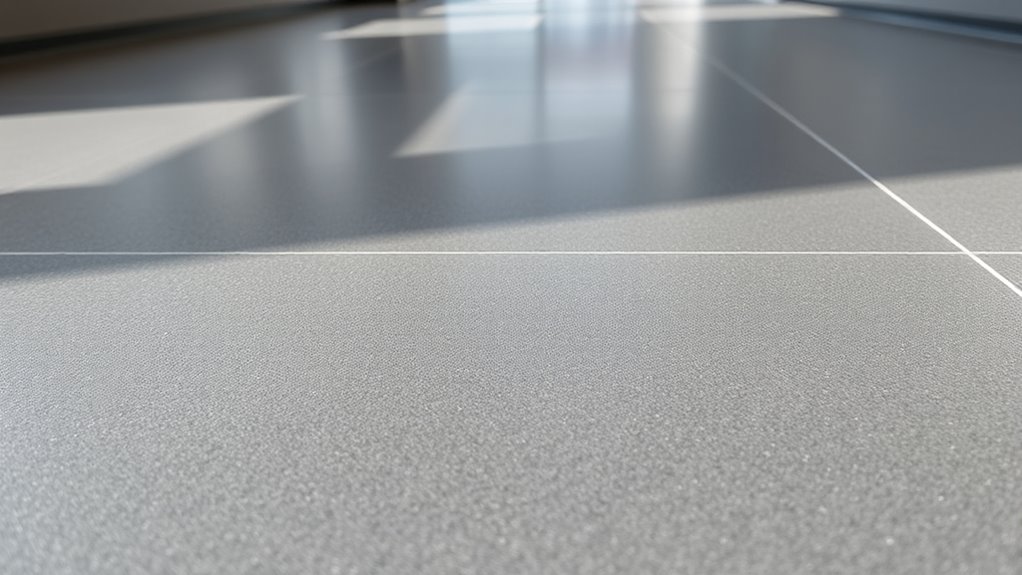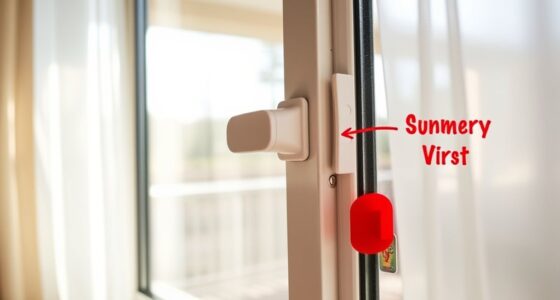When choosing non-slip flooring options, consider textured vinyl, rubber mats, treated tiles, or epoxy coatings, as these materials provide excellent grip in areas prone to moisture or spills. Rubber flooring is durable and ideal for high-traffic zones, while textured vinyl offers easy maintenance and enhanced traction. Proper upkeep is essential to maintain slip resistance over time. To find out more about how to select and care for these floors, continue exploring your options.
Key Takeaways
- Textured vinyl is a popular, easy-to-maintain non-slip flooring material suitable for various settings.
- Rubber flooring offers high durability and excellent slip resistance, ideal for commercial and high-traffic areas.
- Treated ceramic or porcelain tiles with slip-resistant coatings enhance safety in moisture-prone zones.
- Epoxy coatings can be customized with slip-resistant additives for long-lasting, safe surfaces.
- Anti-slip rugs and mats can be used as supplementary safety measures on existing flooring.

When safety is a top priority, choosing the right flooring becomes essential, especially in areas prone to moisture or spills. Slip resistance is a key factor to consider when selecting non-slip flooring options, as it directly impacts how secure you feel walking across a surface. You want flooring that provides enough grip to prevent slips and falls, even when the surface is wet or oily. Materials like textured vinyl, rubber, or certain treated tiles are designed specifically to enhance slip resistance. These surfaces often feature patterns or coatings that increase traction, making them ideal for kitchens, bathrooms, or commercial spaces where spills are frequent.
Prioritize slip-resistant materials like textured vinyl or rubber for safer, moisture-prone areas.
In addition to slip resistance, flooring maintenance plays a significant role in keeping your floors safe and effective over time. Non-slip surfaces can sometimes trap dirt or moisture if not properly maintained, which can reduce their effectiveness and compromise safety. Regular cleaning removes debris that might cause slips, and using appropriate cleaning products ensures the surface retains its slip-resistant properties. For instance, some rubber flooring requires gentle scrubbing with mild cleaners, while textured vinyl might need periodic sealing to preserve its grip. It’s important to follow manufacturer recommendations for maintenance routines to keep the flooring in optimal condition.
Choosing non-slip flooring also means considering durability and ease of upkeep. Rubber flooring, for example, is highly durable and easy to clean, making it suitable for high-traffic areas. Similarly, textured vinyl or epoxy coatings can withstand frequent cleaning and resist wear, maintaining their slip-resistant features for years. When maintaining these floors, avoid harsh chemicals that could degrade the surface or reduce its slip resistance. Instead, opt for gentle, pH-balanced cleaners and avoid abrasive scrubbers that might damage the texture or coating.
Additionally, selecting flooring with proper slip-resistant features can help prevent accidents and enhance overall safety in your space. Another aspect to keep in mind is that some non-slip flooring options may require periodic inspections to ensure they maintain their slip resistance. Over time, dirt buildup or surface wear can lessen traction, so routinely checking your flooring and reapplying treatments or coatings when necessary helps sustain safety. By proactively managing both slip resistance and flooring maintenance, you create a safer environment that minimizes risks and extends the life of your flooring. Ultimately, investing in the right non-slip surfaces and maintaining them diligently ensures you and others can move confidently, regardless of conditions.
Frequently Asked Questions
Which Non-Slip Flooring Is Most Environmentally Friendly?
You’ll find that cork and bamboo are among the most environmentally friendly non-slip flooring options. Both use sustainable materials, with cork harvested without damaging trees and bamboo growing rapidly. These eco-friendly options reduce your carbon footprint and promote sustainability. By choosing cork or bamboo, you’re opting for durable, non-slip surfaces that are safe and environmentally conscious, making them ideal for eco-minded projects and spaces prioritizing sustainability.
How Does Non-Slip Flooring Perform in Outdoor Conditions?
You’ll find that non-slip flooring performs well outdoors, thanks to its weather resistance and durability considerations. It withstands rain, snow, and sun without losing grip or deteriorating quickly. However, you should choose options specifically designed for outdoor use, as some might wear faster or become slippery when wet. Regular maintenance helps preserve its performance, ensuring you get the best safety and longevity from your outdoor non-slip flooring.
Can Non-Slip Flooring Be Installed Over Existing Surfaces?
Yes, you can install non-slip flooring over existing surfaces, but you need to guarantee proper surface preparation. First, check adhesive compatibility to find the right bonding agents. Clean the old surface thoroughly, remove any debris or grease, and repair any damages. This prep work helps the new flooring adhere properly. Following these steps guarantees a secure, lasting installation without issues related to adhesion or uneven surfaces.
What Is the Typical Lifespan of Non-Slip Flooring?
Think of your non-slip flooring as a sturdy ship sailing through years of daily activity. Typically, it lasts around 5 to 10 years, depending on durability expectations and maintenance requirements. Regular cleaning and prompt repairs help extend its life, keeping it safe and effective. With proper care, your flooring can weather the storm of foot traffic, providing reliable slip resistance and peace of mind for years to come.
Are There Any Health Risks Associated With Non-Slip Flooring Materials?
You might worry about health risks with non-slip flooring, but generally, slip hazards are minimized, reducing fall injuries. However, some materials could pose chemical exposure risks if they contain harsh substances or volatile compounds. Always choose non-slip flooring certified as safe and low-emission, and guarantee proper installation and ventilation. This way, you protect yourself from slip hazards while avoiding potential chemical exposure risks.
Conclusion
When choosing non-slip flooring, remember that safety often outweighs style, but this isn’t always the case. Some believe textured surfaces inherently provide better grip, yet recent studies suggest that proper maintenance and material choice matter more. You might find that a combination of textured surfaces and slip-resistant coatings offers the best protection. Ultimately, evaluating your specific environment and staying informed about new innovations ensures you select the safest, most effective flooring option for your needs.









